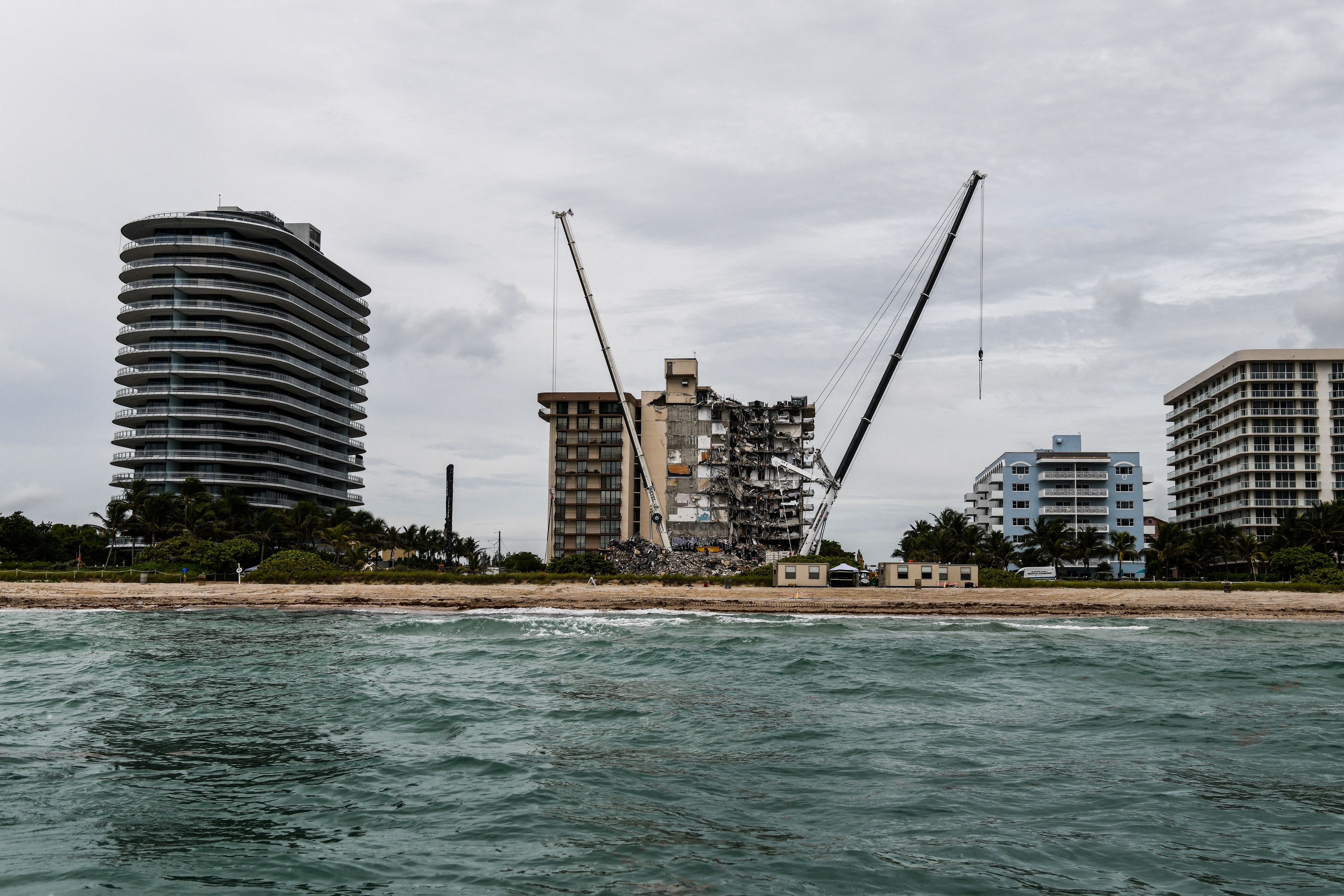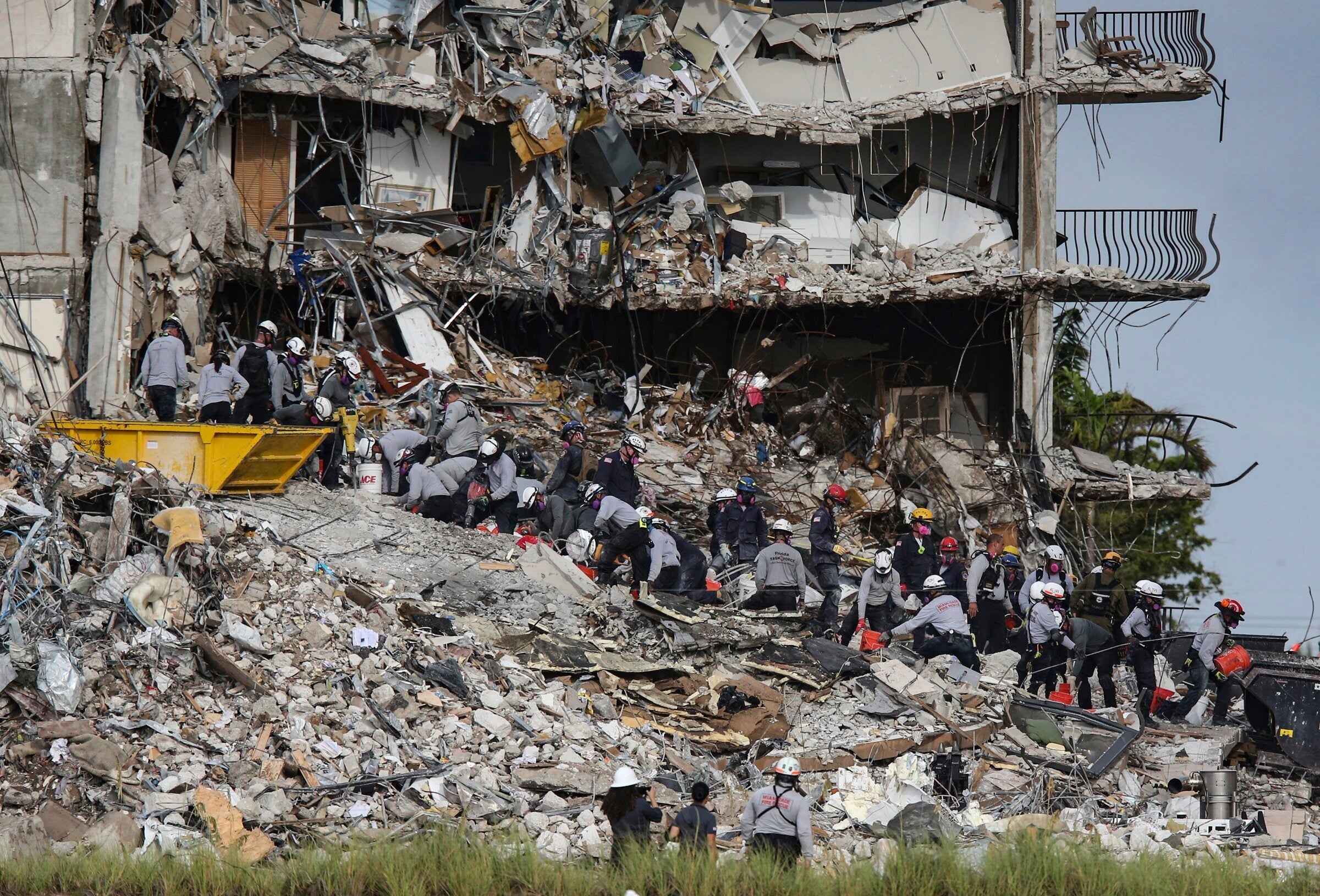In the aftermath of devastating Florida building collapse, neighbours ask: Could it happen to me?
In wake of building collapse, some residents of Miami Beach have called for answers about their own homes

Your support helps us to tell the story
From reproductive rights to climate change to Big Tech, The Independent is on the ground when the story is developing. Whether it's investigating the financials of Elon Musk's pro-Trump PAC or producing our latest documentary, 'The A Word', which shines a light on the American women fighting for reproductive rights, we know how important it is to parse out the facts from the messaging.
At such a critical moment in US history, we need reporters on the ground. Your donation allows us to keep sending journalists to speak to both sides of the story.
The Independent is trusted by Americans across the entire political spectrum. And unlike many other quality news outlets, we choose not to lock Americans out of our reporting and analysis with paywalls. We believe quality journalism should be available to everyone, paid for by those who can afford it.
Your support makes all the difference.In the days since the sudden collapse of a residential tower block in the Florida town of Surfside, and as rescue workers continue to search in the rubble for survivors, many neighbours and residents of nearby Miami Beach have wondered the same thing: Could it happen to me?
For Robert Lisman, those concerns were more pressing than most. The 27-year-old marketing manager lives in the Champlain Towers East, built by the same developer as the collapsed south tower a decade later, and just one plot away.
Still in shock and surrounded by devastation, he began a frantic search for answers about the safety of his own home.
“I think we all grieve differently, and I felt that the first thing that I could do is try to help my own building, because we had structural damage as a result of the south tower collapse,” he says.
There was cause for concern. In the parking garage he noticed a chunk of concrete missing from a column and exposed metal. He called for an immediate inspection of the building’s structural integrity.
He was not alone in fearing the worst. Many residents of this close-knit beachside community have spent the past week wondering what might have been, and what still might be. There had been warnings for years about the condition of the Champlain Tower, but no one predicted that the 12-story building would fall to the ground like it did on that quiet, dark night. Were other buildings at risk?
Just a mile south in Miami Beach, residents of Maison Grande Condominium, an 18-story building with more than 500 apartments, also raised the alarm, sharing photographs of corroded steel and concrete spalling with Local News 10. At the entrance to the building there is a red “unsafe structure” violation notice.
Even Surfside’s mayor, Charles Burkett, raised questions about Champlain Tower North, an identical design to the building on the other side of the east tower.
“If you ask me if I would want to spend the night in that building, I would not be willing to do that,” he said of the structure.
Theories as to why the building collapsed have abounded since the tragedy struck — everything from damage caused by rising sea waters and extreme weather native to south Florida, poor waterproofing or just bad construction practices. The investigation will likely take some time, but what is already known is that the building was in a state of disrepair.
South Florida has some of the strictest building codes in the country precisely because of its experience with hurricanes and severe storms. It was a lesson learned following Hurricane Andrew in 1992, when 65 died and countless homes were destroyed.

Structures built before that, however, are not subject to the same code. Those buildings are only required to carry out a mandatory recertification process to ensure it is structurally sound after 40 years. The Champlain South Tower condominium, built in 1981, was just about to begin that process, but there are many more buildings across the city and county that are overdue.
City and county officials moved quickly to address concerns of residents living in other buildings that may have been at risk. Some 48 hours after the collapse, Miami-Dade mayor Daniella Levine Cava ordered an emergency audit of all residential buildings five stories or higher that are overdue for recertification.
The county is sending inspectors to 24 buildings that are facing unsafe structure violations for failing to recertify in time, according to the Miami Herald.
Other buildings close to the site of the collapse were examined too, Lisman’s condo was one of them. But he says the frustrating path to realising that emergency inspection was indicative of the same issues that may have played a role in the South Tower’s collapse.
“When I tried to get help from my condo association I was met with the same lackadaisical approach that the management and the south tower had, which is a wait-and-see attitude,” he says.
It was only after the involvement of the deputy mayor’s office that the inspection in his own building took place. That check found no cause for immediate concern, so he quickly began devoting as much time as possible to understanding what happened to his neighbours.
At the latest count, 12 people have been confirmed dead and 149 are still missing after the residential building fell in on itself in the early hours of Thursday morning.
“I went through shock, sadness and anger, in that order, because this shouldn’t have happened anywhere in the world, but especially in a developed country where we know how to build, we’re not new to construction in America,” Lisman says.
“And when I see neglect and incompetence at the highest level, and that’s where the anger kicks in.”
Lisman is convinced that new regulations need to be put in place to ensure critical structural repairs are carried out in a timely manner.
“Condo associations do more than just choose the colour of the carpet or, you know, the equipment that’s in the exercise room. They’re making life and death decisions, and the majority of people that serve on them are not qualified to be making life and death decisions,” he says.
One of the questions hanging over the South Tower tragedy is why a 2018 inspection report written by an engineer which found “major structural damage” was not acted on sooner.
Morabito Consultants, which produced the report, also uncovered “abundant cracking and spalling” and noted the need for “extremely expensive” repairs to protect against further deterioration.
While it did not specify any immediate danger, the damage was significant and it is not clear why those recommendations were not acted upon sooner.
By chance, the same firm and the same inspector were hired to look at Lisman’s building. In their case, the condo association made the decision to pay for the repairs.
“He visited our building and we hired him to produce a report. He found areas that needed to be repaired and we did it. We spent millions. We needed to fix the balconies. We replaced them — the posts, the concrete, the rebar. We did all the work to make sure that we’re in good condition. It hurt our pocketbooks. I’m still paying for it, but looking back, I think it was the right decision.”
As the search for survivors continues in Surfside, so too does the search for any buildings at risk.
Edward Rojas, a county administrator who oversees inspections, told the Miami Herald that there are 1,000 active cases being looked at by the board for overdue recertifications.
“We’re out there doing inspections on what kind of condition these buildings are in,” he told the newspaper. “If there’s something obvious that catches their attention, we’ll notify the property and they’ll have to get an engineer to conduct a proper inspection.”
Lisman says he is driven to make sure this never happens again. He has spent days researching possible causes, missed warnings and contributing factors to the collapse. He would like to see new regulations put in place that ensure warnings about structural damage cannot be ignored.
“If we don’t pay attention to what happens next, then this could just be swept under the rug and forgotten, and then it could happen again,” he says.





Join our commenting forum
Join thought-provoking conversations, follow other Independent readers and see their replies
Comments